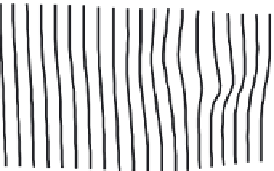Biology Reference
In-Depth Information
4
3
5
2
6
14
15
7
1
16
13
8
12
11
10
9
FIGURE 13.2
A single PW used to exemplify the procedure for finding systematic characters in ontogenies of
shape in Fink and Zelditch, 1995.
invariant to the selection of variables. A result that depends on using partial warps is
invalid (even if the phylogenetic inference based on it happens to be valid) because a par-
tial warp score is a single variable, a one-dimensional projection onto a particular basis
(defined by the reference shape), and our results cannot depend on that choice. Adhering
to this basic principle does not mean that our
phylogenetic results
will be invariant to our
choice of
characters
the results of a phylogenetic analysis always depend on the charac-
ters. Rather, it means that our recognition of characters must be invariant to the selection
of variables
and for that reason, a morphometric variable cannot be a character in its
own right.
The obvious question is: how
can
we discover characters when we cannot look at indi-
vidual morphometric variables? If variables do not provide a legitimate basis for subdivid-
ing the organism, and if conventional anatomical lines of dissection are also viewed as
biologically arbitrary, then where can we look for characters? We end this section with
that question because we have no satisfying answer. In the next section, we discuss two
possible lines of attack. One uses a standard multivariate ordination method, principal
components analysis (PCA), to explore similarities and differences, the other uses pairwise
contrasts to find differences, which are then compared to find similarities among taxa in
their differences from others. Neither method is tailored to the problem, but both represent
feasible approaches that can be used in the interim, until we have a more satisfying
method.



























































































































































































